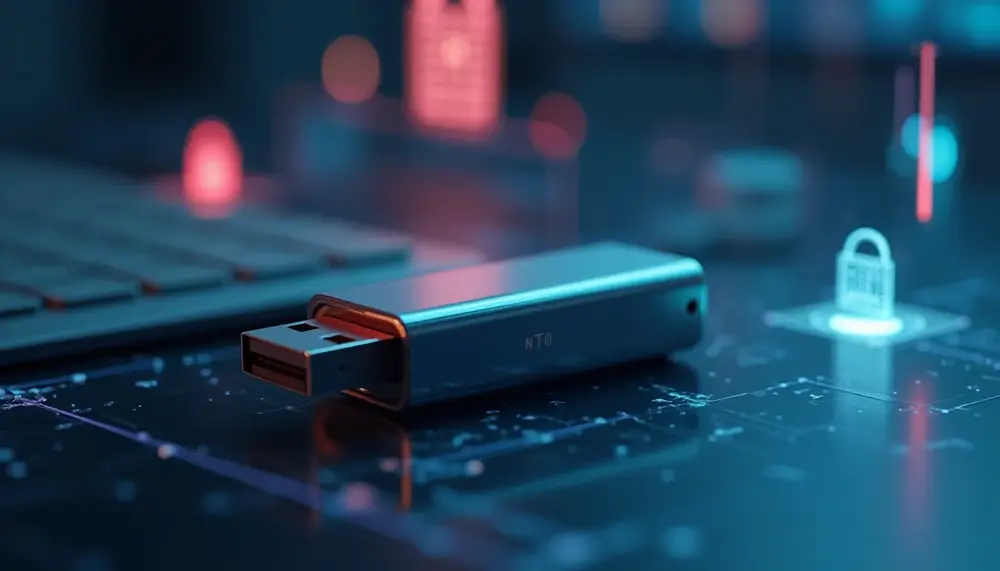Table of Contents:
What Are USB Hardware Wallets and Why Are They Essential for Crypto Security?
USB hardware wallets are compact, physical devices designed to store the private keys of your cryptocurrency assets securely offline. Unlike software wallets that remain connected to the internet, USB wallets function as a form of cold storage, isolating your sensitive data from potential online threats. This offline nature makes them an essential tool for safeguarding digital assets against hacking, phishing, and malware attacks.
What sets USB hardware wallets apart is their ability to combine robust security with user-friendly functionality. These devices often include advanced encryption technologies, such as secure element chips (e.g., CC EAL5+ certification), which ensure that private keys remain inaccessible even if the wallet is physically tampered with. Additionally, most models feature built-in screens for transaction verification, adding an extra layer of protection by allowing users to confirm details directly on the device.
But why are they so critical for crypto security? The answer lies in the principle of ownership. As the saying goes, "Not your keys, not your coins." USB wallets empower users to take full control of their private keys, eliminating reliance on third-party platforms like exchanges, which are frequent targets of cyberattacks. This autonomy not only enhances security but also ensures that your assets remain accessible even in the event of exchange failures or regulatory restrictions.
Furthermore, USB hardware wallets are versatile, supporting a wide range of cryptocurrencies and tokens, including Bitcoin, Ethereum, and even NFTs. Some models also offer additional features like staking, enabling users to earn rewards while keeping their assets secure. With their portability, ease of use, and unmatched security features, USB wallets are an indispensable tool for anyone serious about protecting their crypto investments.
Top Features to Look for in USB Hardware Wallets
When selecting a USB hardware wallet, it’s crucial to focus on features that enhance both security and usability. These devices are not all created equal, and the right combination of functionalities can make a significant difference in protecting your crypto assets. Below are the top features to prioritize when evaluating USB hardware wallets:
- Multi-Currency Support: Look for wallets that support a wide range of cryptocurrencies and tokens. This ensures flexibility and future-proofing as your portfolio diversifies.
- Customizable Security Settings: Advanced wallets allow users to configure security measures such as PIN codes, passphrases, or even multi-signature setups for added protection.
- Secure Firmware Updates: A reliable wallet should offer regular firmware updates that are cryptographically signed to prevent unauthorized modifications.
- Durability and Build Quality: Opt for wallets made from robust materials, such as metal casings, to withstand physical damage or wear over time.
- Integration with Third-Party Services: Some wallets provide compatibility with decentralized applications (dApps) or DeFi platforms, enabling seamless interaction with the broader crypto ecosystem.
- Recovery Options: Beyond the standard recovery phrase, some wallets offer additional backup methods, such as encrypted microSD cards, for enhanced redundancy.
- User Interface and Accessibility: Intuitive navigation and clear instructions are essential, especially for beginners. Features like touchscreen displays or haptic feedback can improve usability.
- Tamper-Evident Design: Certain wallets include physical indicators that reveal if the device has been tampered with, providing peace of mind before use.
- Power Efficiency: USB wallets with low power consumption are ideal for prolonged use, especially when connected to mobile devices or laptops.
By carefully evaluating these features, you can select a USB hardware wallet that aligns with your specific needs, offering a balance of security, functionality, and convenience. Remember, the best wallet is the one that not only protects your assets but also fits seamlessly into your daily crypto management routine.
How USB Wallets Safeguard Your Crypto Assets Offline
USB wallets play a pivotal role in safeguarding your crypto assets by leveraging offline storage and advanced security mechanisms. Their design ensures that private keys never come into contact with internet-connected devices, significantly reducing the risk of cyberattacks. But how exactly do they achieve this level of protection? Let’s break it down:
- Air-Gapped Environment: USB wallets operate in an isolated, offline environment. This "air gap" prevents hackers from remotely accessing your private keys, even if your computer or smartphone is compromised.
- Secure Transaction Signing: When you initiate a transaction, the USB wallet signs it internally using your private key. The signed transaction is then sent back to the connected device without ever exposing the key itself, ensuring complete confidentiality.
- Physical Authentication: Many USB wallets require physical confirmation, such as pressing a button or entering a PIN on the device, before any transaction is approved. This adds an extra layer of defense against unauthorized access.
- Resilience Against Malware: Since the private keys are stored within the hardware and never leave the device, even malware on your computer cannot extract or manipulate them.
- Immutable Firmware: Some USB wallets utilize firmware that is locked or cryptographically verified, ensuring that malicious software cannot alter the device's functionality.
- Limited Attack Surface: By minimizing connectivity options (e.g., no Wi-Fi or Bluetooth), USB wallets reduce potential entry points for attackers, making them inherently more secure than other wallet types.
In essence, USB wallets safeguard your crypto assets by creating a fortress of offline security. They act as a secure intermediary, allowing you to interact with blockchain networks without ever exposing your private keys to the vulnerabilities of the online world. This combination of physical security and digital isolation makes them an indispensable tool for protecting your investments.
Step-by-Step Guide to Setting Up and Using a USB Crypto Wallet
Setting up and using a USB crypto wallet might seem intimidating at first, but with the right steps, it’s a straightforward process. Below is a clear, step-by-step guide to help you securely configure and start using your USB hardware wallet:
- Step 1: Purchase from a Trusted Source Always buy your USB wallet directly from the manufacturer or an authorized reseller. This ensures the device hasn’t been tampered with before reaching you.
- Step 2: Inspect the Packaging Upon receiving your wallet, check for tamper-evident seals or any signs of damage. If anything looks suspicious, contact the manufacturer immediately.
- Step 3: Initialize the Wallet Connect the wallet to your computer or mobile device using the provided USB cable. Follow the on-screen instructions to initialize the device. This usually involves setting up a PIN code for access.
- Step 4: Generate a Recovery Phrase During setup, the wallet will generate a recovery phrase (usually 12-24 words). Write this down on paper and store it in a secure, offline location. Never save it digitally or share it with anyone.
- Step 5: Install the Companion Software Download the official wallet management software or app recommended by the manufacturer. This software will allow you to manage your assets, view balances, and initiate transactions.
- Step 6: Add Cryptocurrencies Once your wallet is set up, you can transfer cryptocurrencies to it. Use the wallet software to generate a receiving address, then send funds from your exchange or other wallets to this address.
- Step 7: Verify Transactions Before confirming any transaction, verify the details (amount, address) on the wallet’s screen. This ensures you’re not falling victim to malware or phishing attempts.
- Step 8: Regularly Update Firmware Periodically check for firmware updates from the manufacturer. Updating ensures your wallet stays protected against newly discovered vulnerabilities.
- Step 9: Disconnect When Not in Use After completing your transactions, safely eject and disconnect the wallet. Keeping it offline when not in use adds an extra layer of security.
By following these steps, you can ensure that your USB crypto wallet is set up correctly and used securely. Taking the time to configure it properly not only protects your assets but also gives you peace of mind in managing your cryptocurrency investments.
Best USB Wallet Models for Beginners and Advanced Users
Choosing the right USB wallet depends on your level of experience and specific needs. Whether you're a beginner just starting with crypto or an advanced user managing a diverse portfolio, there are wallet models tailored to suit your requirements. Below, we highlight some of the best options for both categories:
- For Beginners:
- Ledger Nano S Plus: This wallet is ideal for newcomers due to its affordability and straightforward interface. It supports over 5,500 cryptocurrencies and provides a secure entry point into the world of crypto storage.
- Trezor Model One: Known for its simplicity, the Trezor Model One is a beginner-friendly option with essential security features. It offers compatibility with major coins like Bitcoin and Ethereum, making it perfect for users with basic needs.
- SafePal S1: A budget-friendly wallet with a user-friendly design, SafePal S1 supports a wide range of assets and comes with a companion app for easy management.
- For Advanced Users:
- Ledger Nano X: Designed for experienced users, the Nano X offers Bluetooth connectivity, a larger memory capacity, and support for thousands of cryptocurrencies. Its portability and advanced features make it a top choice for managing complex portfolios.
- Trezor Model T: This premium wallet features a touchscreen for enhanced usability and supports advanced security options like Shamir Backup. It’s ideal for users who prioritize both functionality and cutting-edge protection.
- Ellipal Titan: A completely air-gapped wallet, the Ellipal Titan is built for maximum security. Its rugged design and QR code-based transactions make it a favorite among users seeking high-end protection.
Each of these wallets offers unique advantages, catering to different levels of expertise and investment strategies. Beginners should focus on simplicity and essential features, while advanced users can benefit from enhanced connectivity, larger asset support, and premium security options. Selecting the right model ensures a smoother and safer crypto management experience tailored to your needs.
Key Factors to Consider When Choosing the Right USB Wallet
Choosing the right USB wallet is a critical step in securing your cryptocurrency investments. With numerous options available, understanding the key factors that align with your needs can make all the difference. Here are the most important considerations to guide your decision:
- Supported Ecosystem: Beyond the number of cryptocurrencies supported, consider whether the wallet integrates with decentralized finance (DeFi) platforms, staking protocols, or NFT marketplaces. Advanced ecosystem compatibility can enhance your wallet's functionality.
- Backup and Redundancy Options: Evaluate the wallet's recovery solutions. Some models offer innovative backup methods, such as encrypted microSD cards or multi-device synchronization, providing additional layers of security in case of loss or damage.
- Portability and Design: If you plan to use your wallet on the go, opt for a compact and lightweight design. Additionally, consider features like dust or water resistance for added durability in various environments.
- Open-Source Firmware: Wallets with open-source firmware allow the community to audit the code for vulnerabilities, ensuring transparency and trustworthiness. This is especially important for users who prioritize security and accountability.
- Customer Support and Documentation: Reliable customer support and comprehensive user guides can be invaluable, particularly for troubleshooting or understanding advanced features. Look for brands with a strong reputation for assisting their users.
- Future-Proofing: Consider whether the wallet is equipped to handle emerging technologies, such as support for new blockchain networks or post-quantum cryptography. Future-proof wallets can save you from needing an upgrade later.
- Price vs. Features: While premium wallets offer advanced capabilities, assess whether these features align with your needs. Beginners may find mid-range models sufficient, while experienced users might benefit from investing in high-end devices.
By carefully weighing these factors, you can select a USB wallet that not only meets your current requirements but also adapts to your evolving crypto journey. A well-chosen wallet ensures both security and convenience, giving you peace of mind as you manage your digital assets.
Protecting Your Recovery Phrase and Avoiding Common Threats
Your recovery phrase is the single most critical element of your USB wallet’s security. It acts as the master key to access your cryptocurrency assets, making its protection absolutely essential. Mismanaging or exposing this phrase can lead to irreversible loss of funds. Below are practical strategies to safeguard your recovery phrase and avoid common threats:
- Store Offline Only: Never save your recovery phrase digitally, such as in cloud storage, email, or on your phone. Instead, write it down on paper or use specialized tools like metal backup plates that are resistant to fire, water, and physical damage.
- Use Multiple Backup Locations: Create multiple copies of your recovery phrase and store them in separate, secure locations. For example, one copy could be in a home safe, while another is kept in a safety deposit box.
- Avoid Sharing: Treat your recovery phrase as strictly confidential. Do not share it with anyone, even with trusted individuals, unless absolutely necessary. Scammers often pose as support agents or friends to trick users into revealing their phrases.
- Beware of Phishing Attacks: Be cautious of fake websites, emails, or messages that request your recovery phrase. Legitimate wallet providers will never ask for this information under any circumstances.
- Test Your Backup: Periodically test your recovery phrase by restoring it on a secondary wallet or device. This ensures that the phrase is correctly recorded and functional in case of an emergency.
- Consider Shamir Backup: Advanced users can use wallets that support Shamir Secret Sharing, which splits the recovery phrase into multiple parts. This way, no single part can unlock the wallet, adding an extra layer of security.
- Protect Against Physical Theft: If storing your recovery phrase in a physical location, ensure it is in a secure, tamper-proof environment. Avoid obvious hiding spots like under mattresses or in drawers.
By implementing these measures, you can significantly reduce the risk of losing access to your funds or falling victim to scams. Remember, your recovery phrase is irreplaceable—treat it with the highest level of caution and care.
Tips to Maximize the Security of Your USB Hardware Wallet
Maximizing the security of your USB hardware wallet requires more than just basic precautions. By adopting advanced strategies and staying vigilant, you can ensure your crypto assets remain protected against evolving threats. Here are some expert tips to elevate your wallet’s security:
- Enable Passphrase Protection: Many USB wallets allow you to add an additional passphrase on top of your recovery phrase. This creates a hidden layer of security, as even if someone accesses your recovery phrase, they won’t be able to unlock your funds without the passphrase.
- Use a Dedicated Device: Connect your USB wallet only to a clean, dedicated device that is not used for everyday browsing or downloading. This minimizes exposure to malware or keyloggers.
- Regularly Audit Transactions: Periodically review your transaction history to ensure there are no unauthorized activities. This proactive approach helps you detect potential issues early.
- Physically Secure Your Wallet: Store your USB wallet in a secure location, such as a locked safe or a tamper-proof case. Avoid leaving it in places prone to theft or environmental damage.
- Disable Unnecessary Features: If your wallet supports optional features like Bluetooth, disable them unless absolutely necessary. Reducing connectivity options limits potential attack vectors.
- Beware of Supply Chain Attacks: Before using your wallet, verify its authenticity by checking the manufacturer’s security seals and confirming the device's firmware matches the official version.
- Use Multi-Wallet Strategies: For added security, consider splitting your assets across multiple USB wallets. This diversification reduces the risk of losing all your funds in case one wallet is compromised.
- Educate Yourself Continuously: Stay informed about the latest security threats and updates in the crypto space. Awareness is a powerful tool in protecting your assets.
By implementing these advanced measures, you can significantly enhance the security of your USB hardware wallet. In the ever-changing landscape of cryptocurrency, a proactive and layered approach to security is your best defense.
Benefits of USB Wallets Over Other Cold Wallet Alternatives
USB wallets stand out among cold wallet alternatives due to their unique combination of security, usability, and advanced features. While other cold storage options, such as paper wallets or offline computers, provide a degree of protection, USB wallets offer distinct advantages that make them a preferred choice for many crypto users.
- Enhanced Portability: Unlike offline computers or air-gapped devices, USB wallets are compact and easy to carry. This makes them ideal for users who need secure access to their assets while traveling or managing multiple locations.
- Built-In Transaction Verification: USB wallets often include screens or secure displays that allow users to verify transaction details directly on the device. This feature is absent in simpler cold storage methods like paper wallets, providing an additional layer of trust and accuracy.
- Durability and Longevity: Many USB wallets are designed with robust materials, such as metal casings, to withstand physical damage. In contrast, paper wallets are highly susceptible to environmental factors like water, fire, or wear and tear over time.
- Support for Advanced Features: USB wallets frequently support staking, DeFi integrations, and NFT management, which are functionalities that paper wallets or basic offline methods cannot provide. This makes them more versatile for modern crypto needs.
- Regular Firmware Updates: Unlike static cold storage solutions, USB wallets can be updated with the latest security patches and features, ensuring they remain resilient against emerging threats.
- User-Friendly Setup: While offline computers or complex multisig setups can be challenging for non-technical users, USB wallets are designed with intuitive interfaces and guided setup processes, making them accessible even for beginners.
- Tamper Resistance: Many USB wallets include tamper-evident designs or secure element chips that protect against physical attacks. This level of hardware security is rarely found in other cold wallet alternatives.
By combining portability, advanced functionality, and robust security, USB wallets offer a superior solution for safeguarding digital assets. Their adaptability to evolving crypto ecosystems and user-friendly design make them a standout choice for both novice and experienced investors seeking reliable cold storage.
Final Thoughts: Why USB Wallets Are a Must-Have for Crypto Investors
As the cryptocurrency landscape continues to evolve, the importance of secure storage solutions becomes increasingly evident. USB wallets have emerged as an indispensable tool for crypto investors, offering a unique blend of security, control, and convenience that other storage methods often fail to match.
One of the standout advantages of USB wallets is their ability to empower users with complete ownership of their digital assets. By storing private keys offline, these wallets eliminate reliance on third-party platforms, reducing exposure to exchange hacks or regulatory uncertainties. This independence aligns perfectly with the decentralized ethos of cryptocurrency.
Additionally, USB wallets cater to a wide spectrum of users, from beginners to seasoned investors. Their adaptability ensures that both small-scale holders and those managing diverse, high-value portfolios can find a solution tailored to their needs. With support for advanced features like staking and NFT management, USB wallets also position themselves as future-ready tools in a rapidly changing market.
For those serious about protecting their investments, USB wallets are not just an option—they are a necessity. Their combination of offline security, user-centric design, and advanced functionalities makes them a cornerstone of any robust crypto strategy. In a world where digital threats are constantly evolving, investing in a reliable USB wallet is a proactive step toward safeguarding your financial future.
FAQ About USB Hardware Wallets for Crypto Security
What is a USB hardware wallet and why is it important?
A USB hardware wallet is a physical device that stores your private keys offline, protecting your cryptocurrency from online threats such as hacking and malware. It's crucial for securely managing your digital assets, as private keys remain isolated from internet-connected devices.
What are the main benefits of using a USB hardware wallet?
Some of the primary advantages include offline storage for enhanced security, protection against phishing and malware, support for multiple cryptocurrencies, and the ability to maintain total control over your private keys, eliminating reliance on third-party platforms.
How do USB wallets safeguard my assets offline?
USB wallets operate in an air-gapped, offline environment. They sign transactions internally without exposing private keys to internet-connected devices. This isolation effectively protects your funds from cyberattacks and unauthorized access.
What features should I look for in a USB hardware wallet?
Key features to consider include multi-currency support, secure firmware updates, a clear interface for transaction verification, advanced backup options, and, for advanced users, compatibility with DeFi platforms or staking capabilities.
How can I securely store my wallet's recovery phrase?
Store your recovery phrase offline on paper or metal plates designed for backups. Keep multiple copies in secure locations like a home safe or a bank deposit box, and avoid saving it digitally. Never share it with anyone, as it grants full access to your funds.












